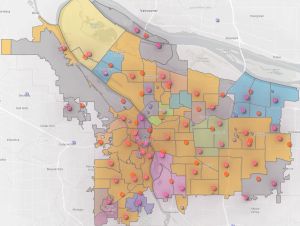Team Service Areas
A Team's Service Area refers to the geographic area within which a NET administers their Operations Plan; it can be thought of as their "turf" and the area they plan to respond inside of in the event of a disaster. Most Service Areas conform with neighborhood boundaries, while others include multiple neighborhoods or a part of a neighborhood. Service Areas are proposed to PBEM by Team Leaders, and PBEM provides final approval. A team should evaluate their Service Area every time they update their Operations Plan.
...
...
Background
Service Area policies changed several times since Portland NET started in 1994, often reflecting the reach of the program and interests of volunteers. In the first years of NET, Service Areas conformed with Portland Fire & Rescue fire management areas (FMAs). As the number of NET volunteers increased over the years, Service Area boundaries shifted to follow Portland's neighborhood system. That is how most Service Areas boundaries are drawn today, but PBEM encourages teams to reconsider their boundaries and "right size" them to match resources and team priorities. Creating more nuanced boundaries is also more plausible than in past years thanks to the use of GIS mapping systems.
...
Job Aid: Creating a Team Service Area Boundary
PBEM offers the following rules and guidance to NETs when developing their Service Area Boundaries:
Service Area Rules
PBEM will only approve Service Areas if they conform with these rules:
- Service Area boundaries shall not overlap with the Service Area boundaries of another team. "Enclaved" boundaries are acceptable.
- Exclaves are not permitted; except in unusual circumstances, boundaries must be contiguous.
General Guidance/Suggestions
The following conditions are not required, but teams should undertake due diligence to propose a Service Area that:
- Is mostly inside City of Portland city limits.
- Includes at least one BEECN and one fire station.
- Is square/rectangular-shaped with four sides (they are significantly easier to process on mapping tools). This will difficult to avoid for some teams that abut freeways or waterways. Nonetheless, PBEM will reject highly gerrymandered Service Areas.
Considerations
- Does the team have the resources to conduct operations safely and effectively inside the proposed Service Area?
- Boundaries can change over time; a team is not "stuck" with the boundaries that PBEM approves. A new proposal can be submitted for approval every time the Operations Plan is updated (at least once every two years). Boundaries may expand or retract.
- How many NET volunteers live inside the Service Area? If you're not sure, a Team Leader can request member addresses from PBEM and drop them into an application such as BatchGeo (as long as the address information is kept strictly confidential). To be a member of a team, a volunteer does not have to reside inside the team's Service Area, but does need to be within walking or biking distance of the NET Staging Area.
